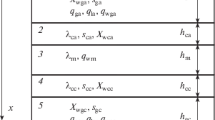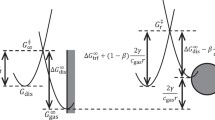Abstract
Two facts form the basis of the present investigation. Firstly: generally, only a fraction of the total quantity of dissolved gas generated at a gas-evolving electrode is evolved in gaseous form directly at the electrode. Secondly: commonly, only a fraction of the complementary amount of dissolved gas reaching the bulk of electrolyte is evolved in the interelectrode gap. This paper analyses the conditions in which a major portion of the total amount of dissolved gas generated at the electrode remains in dissolved form when being withdrawn from the interelectrode gap. Increasing this amount results in lowering the effective resistivity of the gas—electrolyte dispersion.
Similar content being viewed by others
Abbreviations
- A :
-
B gas—electrolyte interfacial area in bulk (m2)
- c :
-
gas concentration in electrolyte bulk (mol m−3)
- d :
-
mean diameter of gas bubbles in bulk (m)
- f G :
-
gas evolution efficiency at electrode (−)
- F :
-
Faraday constant,F = 96 487 A s mol−1
- H :
-
length of interelectrode gap in flow direction (m)
- I :
-
current of generation of dissolved gas (A)
- j :
-
current density (A m−2)
- k :
-
liquid mass transfer coefficient (m s−1)
- K 1 :
-
dimensionless parameter, Equation 5
- K 2 :
-
dimensionless parameter, Equation 6
- K 3 :
-
dimensionless parameter, Equation 7
- n :
-
charge number of the electrode reaction (−)
- N □E :
-
flux to the bulk of liquid (mol s−1)
- N □F :
-
flux of gas evolved in bulk (mol s−1)
- N □G :
-
flux of gas evolved at the electrode (mol s−1)
- N □O :
-
flux of dissolved gas removed from the interelectrode gap (mol s−1)
- p :
-
pressure (kg m−1 s−2)
- R :
-
gas constantR=8.314kg m2 s−2 mol−1 K −1
- T :
-
temperature (K)
- ν 0 :
-
electrolyte velocity at cell entrance (m s−1)
- V L :
-
volumetric flow rate of electrolyte (m3 s−1)
- W :
-
width of flow channel (m)
- x :
-
coordinate in flow direction (m)
- Y :
-
electrode-membrane clearance (m)
- ν :
-
stoichiometric number (−)
- φ :
-
volumetric gas fraction (−)
- H:
-
exit cell
- o:
-
entrance cell
- s:
-
saturation
References
H. Vogt,Chem. -Ing. -Tech. 52 (1980) 418.
Idem, Electrochim. Acta 29 (1984) 167.
Idem, ibid. 29 (1984) 175.
Idem, ibid. 30 (1985) 265.
H. Brauer and D. Sucker,Chem. -Ing. -Tech. 48 (1976) 741.
H. Vogt,Fortschr. Verfahrenstech. 16 (1978) 297.
Idem, ibid. 20 (1982) 369.
J. Fleck,Chem. -Ing. -Tech. 43 (1971) 173.
N. Ibl and H. Vogt, Inorganic electrosynthesis. In ‘Electrochemical processing’ Comprehensive treatise of electrochemistry; Vol. 2 (edited by J. O'M. Bockris, B. E. Conway, E. Yeager and R. E. White) Plenum, New York (1981) p. 206.
A. Coehn,Ber. Dt. Chem. Ges. 60 I (1927) 1078.
G. Tammann and E. Jenckel,Z. Anorg. Allg. Chem. 173 (1928) 337.
J. E. Noeggerath,Z. VDI 72 (1928) 373.
V. Ipatieff, V. Schischkin and S. Jurieff,Z. Elektrochem. 40 (1934) 713.
V. Schischkin and I. Dubkof,ibid. 40 (1934) 724.
Author information
Authors and Affiliations
Rights and permissions
About this article
Cite this article
Krause, B., Vogt, H. Effect of operational parameters on gas evolution in electrolyte bulk: possibilities for lowering interelectrode resistance. J Appl Electrochem 15, 509–515 (1985). https://doi.org/10.1007/BF01059292
Received:
Issue Date:
DOI: https://doi.org/10.1007/BF01059292




